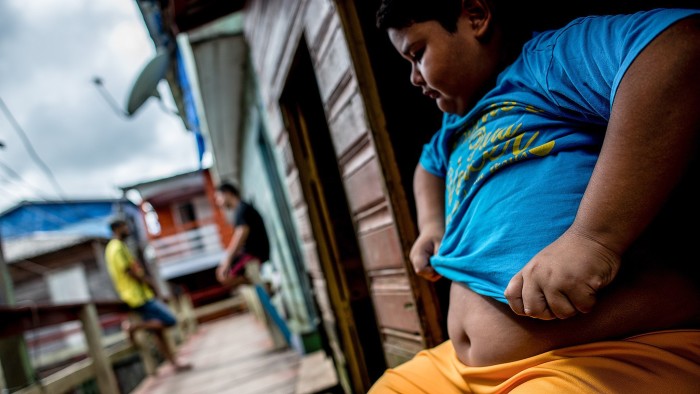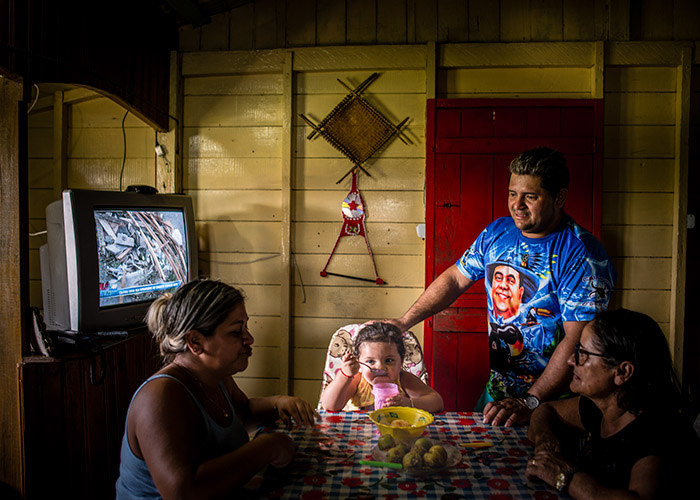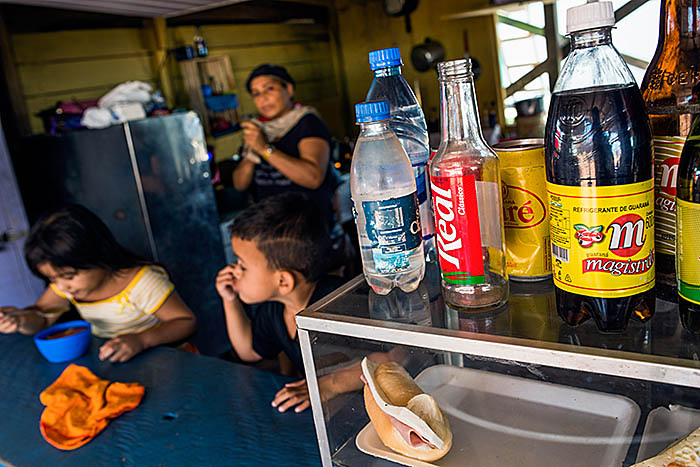Amazonia’s childhood obesity epidemic takes a toll on development

Simply sign up to the Retail & Consumer industry myFT Digest -- delivered directly to your inbox.
Porto de Careiro da Várzea, a one-road town across the river from Manaus, Brazil’s jungle capital, is known locally as “Kilometre Zero” because it is here that route BR319 starts, connecting the city with the rest of the country. But the ferry town, whose houses are built on stilts to beat the annual Amazon floods, is Ground Zero in another sense too — it is at the centre of Brazil’s rising obesity epidemic that some specialists worry could be affecting young children’s development.
It was here that a 2012 Brazilian documentary on obesity, Muito Além do Peso (Way Beyond Weight), shot its opening scenes, which focused on Yan Correa Carneiro, an obese four-year-old, who threw tantrums unless his mother fed him crisps.
Yan is now 10, still obese and at risk of becoming diabetic. Sitting in their comfortable wooden house, his parents say they have stabilised his weight to about 80kg — more than double the average for his age.
“There was a time when he would have lunch here, go to his aunt’s house and have another lunch there, then go to the house of this uncle here,” says Yan’s father, Marcelo Chaves Carneiro, pointing at his wife’s brother, who grins sheepishly.
Once afflicted by hunger, Brazil’s Amazonian cities today are the overweight capitals of one of the developing world’s most obese large countries. Nearly 21 per cent of Brazil’s population aged 15 or over was obese in 2015, according to the OECD.
Data from Brazil’s health ministry show that obesity levels rose 60 per cent in the decade ending 2016. Brazil’s most overweight state capital was Rio Branco in the Amazonian state of Acre, with Manaus and other jungle cities not far behind.

The problem starts early. For children between five and 10 years old, data from the health ministry’s Sisvan (food and nutritional surveillance) system show that in 2008, more than 9 per cent were considered obese or seriously obese. By 2016, this figure had risen to about 13 per cent.
For under-fives, the nationwide obesity rate has not changed much over the same period, according to Sisvan figures. But for the Amazonian states, it rose from 6.5 per cent for the whole region to 8 per cent. In seven out of 62 municipalities in Amazonas, the state of which Manaus is the capital, child obesity levels were above 10 per cent for children aged five years or younger, reaching 11 per cent in the municipality of Ipixuna.
“Ipixuna [is] one of the municipalities with the lowest indices of development here in Amazonas, with difficult access, very distant [from the state capital], and we see that here is a tendency towards childhood obesity,” says Joselina Castro, the co-ordinator for food and nutrition at the state health secretariat.
Nutritionists attribute the gradual rise in obesity among children in the Amazon partly to social welfare benefits, such as bolsa família, a monthly grant for low-income families. While the grant has been lauded for reducing poverty, many families have used part of the cash to buy soft drinks and biscuits instead of natural foods.
“The Amazon especially has a large number of fruits, but children are eating fewer and fewer of them,” says Michele Lessa, the co-ordinator general of food and nutrition at Brazil’s health ministry.
The market in Careiro da Várzea today has barely enough fruit and vegetables on sale to feed a few families. Fresh foods are also more expensive. Before, “you had to eat what you planted or hunted . . . now people don’t move except to go to the supermarket”, says Jerusa de Paula Freitas Brandão, the municipal nutritionist for Careiro da Várzea.

Research from Brazil and overseas into whether obesity affects development of the brain in early childhood and cognitive abilities has produced results for and against the thesis. A 2015 study by Patrícia Zuanetti, a doctorate student at the University of São Paulo, concluded that “obesity can change cognitive performance in children”. While obese children performed slightly better in one of the learning tests, they struggled with exams that required greater mental flexibility.
International authorities such as the Pan American Health Organization talk of micro-nutrient deficiency as a possible part of the obesity epidemic. Ms Lessa, of the ministry of health, says children can be overweight yet suffer from iron deficiency anaemia, affecting early development.
Health workers in the Amazon are convinced there is a connection between obesity and brain development. They are certain that obesity affects both children’s motor skills and their academic performance. “When a person has adequate nutrition, logically the development of this child will be better,” says Ms Castro. “You will have improved mental development.”
In Careiro da Várzea, this message seems to be gaining traction. Another couple, Francisca Queiroz and her husband Edeniy da Costa Nascimento, present their daughter Ana Eloá, a bubbly two-year-old who weighs 19kg and is dressed in clothes designed for eight-year-olds.
Thanks to national, state and municipal programmes to raise awareness among low-income families of obesity, Ana Eloá’s parents have brought her weight down from 22kg. Francisca says the family first sought help when it became clear their baby might be susceptible to diabetes.
“It could be genetic . . . but the blame lies with us as well,” she says.
Comments